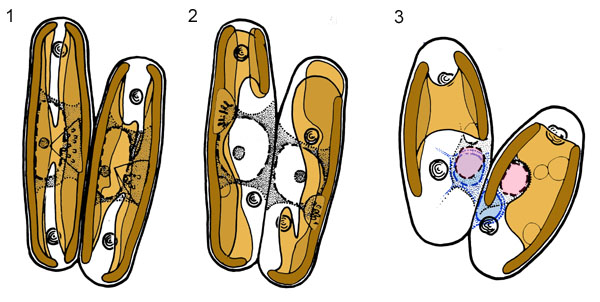Protoplast reorganization
After pairing, sexualized cells of Sellaphora initially (Fig. 1) retain the same protoplast organization as vegetative cells: there is a single H-shaped chloroplast, a tetrahedral pyrenoid lying to one side of the chloroplast isthmus (to the right in both cells in Fig. 1), an ellipsoidal nucleus (containing a single nucleolus) lying on the opposite side to the pyrenoid, and a volutin granule in each of the two polar vacuoles.
As the cells enter meiosis, however, several changes take place, the details depending on the species. Most of the S. pupula group behave as shown in Figs 1 and 2, which show the same pair of S. capitata cells a few hours apart. Here, the chloroplasts move in opposite directions in the two paired cells, so that they lie against the sides of the cells (i.e. against the girdle) away from where the cells bond together. The nuclei move in the other direction, so that they lie close together (at this stage the cell walls are still intact). The nuclei expand and become nearly spherical as they enter meiosis (Fig. 2). In the S. laevissima group, the chloroplasts do not move apart in the same way.
Meiosis I takes place without further movement of the nucleus, producing configurations like that shown in Fig. 3 (the daughter nuclei have been coloured to aid interpretation: they lie in different focal planes, because division takes place at right angles to the image plane, as during mitosis. Meiosis I is accompanied by an unequal cytokinesis, explained on a separate page.
The pre-meiotic rearrangements of the protoplast in the S. pupula group are similar to the rearrangements that occur before mitosis. However, Figs 1 and 2 illustrate a significant difference. In the left-hand cell, the pyrenoid crosses the cell during the pre-meiotic rearrangement, as it would have done if this had been a preparation for mitosis. In the right-hand cell, on the other hand, the pyrenoid scarcely moves. From this and similar observations, we know that:
- cells do not pair in any consistent way with respect to their internal asymmetries (they can pair nucleus-nucleus, nucleus-pyrenoid, or pyrenoid-pyrenoid).
- cells 'know' on which side their partner lies and this information determines which way the protoplast is reorganized: cells almost always adopt the nucleus-nucleus configuration during transition to meiosis.


 This site is hosted by the Royal Botanic
Garden Edinburgh.
This site is hosted by the Royal Botanic
Garden Edinburgh.